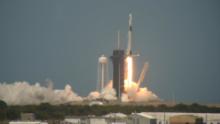SpaceX reuses rocket from historic astronaut mission to launch satellite.

New York (CNN Business)The SpaceX rocket booster that carried two NASA astronauts on a historic journey to the International Space Station two months ago took flight once again on Monday evening — this time to launch a hefty communications satellite into orbit.
The rocket took off from Florida's Cape Canaveral Air Force Station around 5:30 pm ET.
Inside the bulbous nose cone at the rocket's tip was a communications satellite that belongs to the South Korean military. SpaceX did not show the satellite deploying from rocket, something the company typically leaves out of its webcasts when taking sensitive national security-related cargo to space.
But the company did show the landing of its first-stage booster, the bottom-most portion of the rocket equipped with nine massive engines that provided the Falcon 9 rocket's initial thrust at liftoff. The rocket booster SpaceX used for Monday's mission was previously flown on SpaceX's first-ever mission with humans on board.
On May 30 the same rocket vaulted a gumdrop-shaped spacecraft, Crew Dragon, into orbit with NASA astronauts Bob Behnken and Douglas Hurley strapped inside. The men are expected to return from the International Space Station in August.
SpaceX's Falcon 9 rocket is the only launch vehicle in the world that features a reusable first-stage booster. For years, the company has routinely recovered the boosters: After the first-stage spends most of its fuel, it detaches from the rocket's second stage and then steers itself back to an upright landing on seafaring platforms or a ground pad. The second, non-reusable stage of the rocket then fires up its own engine to finish off the mission.
Recapturing, refurbishing and reflying rocket hardware saves SpaceX money, the company says, and it's at the core of CEO Elon Musk's mission to drive down the cost of launching satellites — or people — into outer space. The company's success in developing reusable rocket technology upended a fairly uncompetitive industry, and many of its competitors, such as legacy rocket builder United Launch Alliance and newcomer Blue Origin, are attempting to create reusable vehicles of their own.
SpaceX has flown a single rocket booster up to five times, and Musk has said the latest version of the Falcon 9 first-stage can fly up to 10 times with minimal repairs needed between launches.
During Monday's mission, the first-stage booster fired its engines for about two and a half minutes before breaking off and steering itself back toward one of the company's remote-controlled platforms, called "Just Read the Instructions." (The name comes from one of Musk's favorite sci-fi books.) The whole thing will took about eight and a half minutes.
SpaceX said the South Korean satellite, dubbed Anasis II and built under a Lockheed Martin-Airbus contract, deployed from the rocket's second stage about half an hour after takeoff.
The satellite was slated to launch last week, but SpaceX delayed the mission in order to inspect the rocket's second stage, the company had said in a tweet.
New York (CNN Business)The SpaceX rocket booster that carried two NASA astronauts on a historic journey to the International Space Station two months ago took flight once again on Monday evening — this time to launch a hefty communications satellite into orbit.
The rocket took off from Florida's Cape Canaveral Air Force Station around 5:30 pm ET.
Inside
the bulbous nose cone at the rocket's tip was a communications
satellite that belongs to the South Korean military. SpaceX did not show
the satellite deploying from rocket, something the company typically
leaves out of its webcasts when taking sensitive national
security-related cargo to space.
But
the company did show the landing of its first-stage booster, the
bottom-most portion of the rocket equipped with nine massive engines
that provided the Falcon 9 rocket's initial thrust at liftoff. The
rocket booster SpaceX used for Monday's mission was previously flown on
SpaceX's first-ever mission with humans on board.
On May 30 the same rocket
vaulted a gumdrop-shaped spacecraft, Crew Dragon, into orbit with NASA
astronauts Bob Behnken and Douglas Hurley strapped inside. The men are expected to return from the International Space Station in August.
SpaceX's
Falcon 9 rocket is the only launch vehicle in the world that features a
reusable first-stage booster. For years, the company has routinely
recovered the boosters: After the first-stage spends most of its fuel,
it detaches from the rocket's second stage and then steers itself back
to an upright landing on seafaring platforms or a ground pad. The second, non-reusable stage of the rocket then fires up its own engine to finish off the mission.
Recapturing,
refurbishing and reflying rocket hardware saves SpaceX money, the
company says, and it's at the core of CEO Elon Musk's mission to drive
down the cost of launching satellites — or people — into outer space.
The company's success in developing reusable rocket technology upended a
fairly uncompetitive industry, and many of its competitors, such
as legacy rocket builder United Launch Alliance and newcomer Blue
Origin, are attempting to create reusable vehicles of their own.
SpaceX
has flown a single rocket booster up to five times, and Musk has said
the latest version of the Falcon 9 first-stage can fly up to 10 times
with minimal repairs needed between launches.
During
Monday's mission, the first-stage booster fired its engines for about
two and a half minutes before breaking off and steering itself back
toward one of the company's remote-controlled platforms, called "Just
Read the Instructions." (The name comes from one of Musk's favorite sci-fi books.) The whole thing will took about eight and a half minutes.
SpaceX said the South Korean satellite, dubbed Anasis II and built under a Lockheed Martin-Airbus contract, deployed from the rocket's second stage about half an hour after takeoff.
The
satellite was slated to launch last week, but SpaceX delayed the
mission in order to inspect the rocket's second stage, the company had
said in a tweet.
















No comments:
Post a Comment